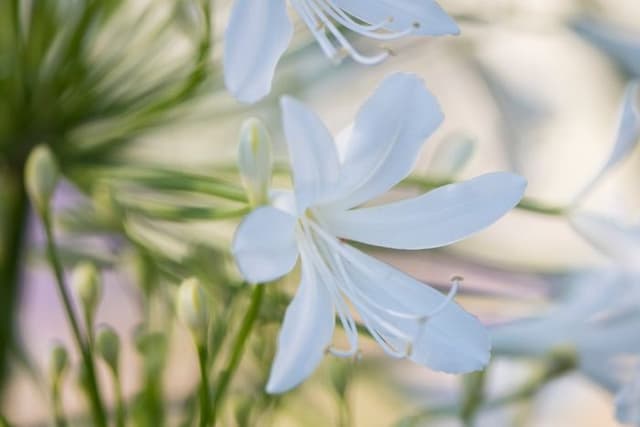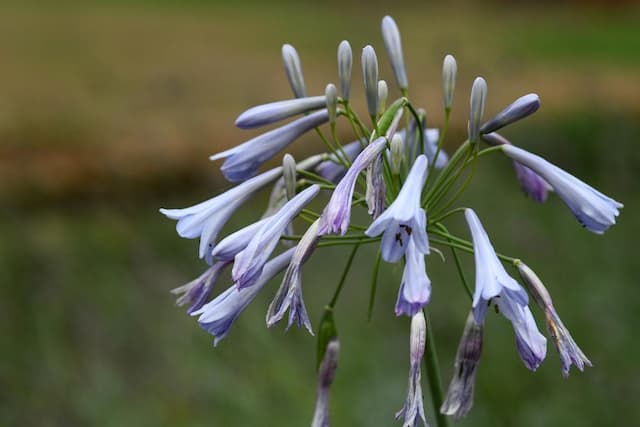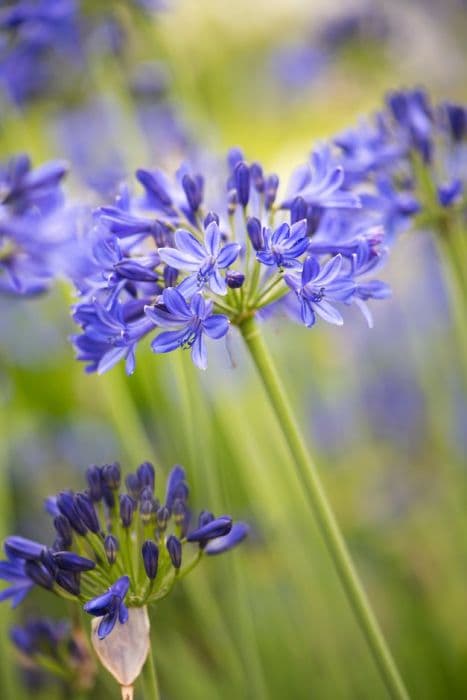African lily 'Blue Ice' Agapanthus 'Blue Ice'

ABOUT
'Blue Ice' is an evergreen perennial to about 1m, with strap-shaped, glossy leaves, purple at the base. Large rounded umbels of very pale blue flower are produced on strong, upright stems from mid-summer to early autumn
About this plant
 Names
NamesFamily
Amaryllidaceae
Synonyms
African Lily, Lily of the Nile, Blue African Lily
Common names
Agapanthus 'Blue Ice'.
 Characteristics
CharacteristicsLife cycle
Perennials
Foliage type
Evergreen
Color of leaves
Green
Flower color
Blue
Height
2 feet (60 cm)
Spread
2 feet (60 cm)
Plant type
Bulb
Hardiness zones
8
Native area
South Africa
Benefits
 General Benefits
General Benefits- Decorative Flowering: Produces striking blue and white flowers that add a splash of color to gardens.
- Drought Tolerance: Once established, it is relatively drought-tolerant, requiring minimal watering.
- Low Maintenance: Requires little care beyond the occasional watering and fertilizing, making it ideal for busy gardeners.
- Attracts Pollinators: Its blooms attract beneficial pollinators such as bees and butterflies, supporting local ecosystems.
- Versatility: Can be planted in borders, containers, or as a focal point in garden designs due to its eye-catching blooms.
- Long Blooming Period: Offers a long flowering season, from early summer to fall, providing sustained garden interest.
- Hardiness: It is hardy in many climates and can withstand frost to some degree once mature.
- Clump-Forming: Forms neat clumps that can be easily divided to propagate new plants and enhance garden displays.
- Soil Adaptability: Tolerates a range of soil types, though it prefers well-draining soil.
- Deer Resistance: Generally resistant to deer, making it suitable for gardens troubled by wildlife.
- Architectural Structure: With its strappy leaves and tall flower stalks, it adds structure and texture to garden arrangements.
 Medical Properties
Medical PropertiesThis plant is not used for medical purposes.
 Air-purifying Qualities
Air-purifying QualitiesThis plant is not specifically known for air purifying qualities.
 Other Uses
Other Uses- Agapanthus 'Blue Ice', also known as Lily of the Nile, can be used in art and photography as a visually striking subject due to its vibrant blue-purple flowers and lush green foliage.
- The plant’s tall and sturdy flower stalks can be used in crafting, particularly in making homemade stakes for other plants in the garden.
- Lily of the Nile can serve as a natural dye source, where the flowers provide shades of blue and the leaves yield green colors when used in traditional fabric dyeing techniques.
- The flowers can be used as a natural confetti at outdoor celebrations, with their petals adding a pop of color that is biodegradable and environmentally friendly.
- Dried Lily of the Nile flowers can be incorporated into potpourri mixes to add bulk and a hint of color, complementing the scent from other dried flowers and herbs.
- The seed pods of the Lily of the Nile can be used in dry flower arrangements or as part of decorative displays due to their unique shape and texture.
- In floristry, the long-lasting cut flowers of Lily of the Nile can be used to create stunning water features by floating blooms in shallow bowls or urns.
- The thick, fleshy roots of Lily of the Nile can be used in experiments on root growth and soil erosion control practices, particularly in educational settings.
- Agapanthus leaves can be used as a natural wrapping material for small bouquets or gifts, promoting a sustainable alternative to paper or plastic.
- The robust structure of Lily of the Nile makes it a useful plant for creating living fences or borders in gardens and landscaping projects, offering both beauty and privacy.
Interesting Facts
 Feng Shui
Feng ShuiThe Agapanthus is not used in Feng Shui practice.
 Zodiac Sign Compitability
Zodiac Sign CompitabilityThe Agapanthus is not used in astrology practice.
 Plant Symbolism
Plant Symbolism- Love Letters: The name Agapanthus comes from the Greek words 'agape' meaning love and 'anthos' meaning flower. Thus, it is often seen as a symbol of love or a messenger of love.
- Beauty: With its striking blue to purple flowers, Agapanthus 'Blue Ice' is commonly associated with beauty and admiring something or someone's attractive appearance.
- Endurance and Survival: Agapanthus is known to be a hardy plant that can thrive in various conditions, symbolizing the ability to endure life's challenges and to survive through difficult times.
- Fertility: Due to its lush growth and abundant flowering, it can symbolize fertility and fruitful endeavors.
 Water
WaterLily of the Nile should be watered once a week, ensuring the soil is kept evenly moist but not waterlogged. During the active growing season in spring and summer, you might need to water it twice a week, depending on the climate. Each watering should be deep enough to soak the soil around the root zone, which typically requires about 1-2 gallons for outdoor plants, depending on size. During the winter months, reduce watering to every other week as the plant's growth slows down. Always check the top inch of soil for dryness before watering to avoid overwatering.
 Light
LightLily of the Nile thrives best in full sun to partial shade conditions. It prefers a spot that receives at least 6 hours of direct sunlight each day for optimal blooming. Morning sun with afternoon shade is ideal, especially in hotter climates, as it can help protect the plant from intense afternoon heat.
 Temperature
TemperatureLily of the Nile can tolerate a wide range of temperatures, but it grows best when the temperatures are between 60 to 75 degrees Fahrenheit. It can survive minimum temperatures of around 50 degrees Fahrenheit, but it should be protected from frost, which can damage the plant. The maximum temperature should not exceed 90 degrees Fahrenheit for prolonged periods, as this can stress the plant.
 Pruning
PruningLily of the Nile should be pruned to remove spent flower stalks and to tidy up the plant, which encourages new growth and more blooms. The best time to prune is after the flowering has finished, usually in late summer or early fall. Cut the flower stalks down to the base, and remove any dead or damaged leaves. Pruning can be done annually or as needed when the plant begins to look untidy.
 Cleaning
CleaningAs needed
 Soil
SoilThe best soil mix for Lily of the Nile ('Blue Ice') should be well-draining, fertile, and loamy, with the ability to retain some moisture. A mix of two parts loam to one part sand and one part compost or well-rotted manure is ideal. The preferred soil pH for this plant is slightly acidic to neutral, ranging from 6.0 to 7.0.
 Repotting
RepottingLily of the Nile ('Blue Ice') should generally be repotted every 2 to 3 years or when it becomes root-bound. It's best to repot in the spring, just before the active growing season begins.
 Humidity & Misting
Humidity & MistingLily of the Nile ('Blue Ice') prefers average household humidity levels. There is no need for high humidity; maintaining levels between 40% and 60% is typically sufficient for this plant.
 Suitable locations
Suitable locationsIndoor
Ensure full sun, well-drained soil, and room for growth.
Outdoor
Plant in a sunny spot, ensure good drainage, and protect from frost.
Hardiness zone
8-11 USDA
 Life cycle
Life cycleThe Agapanthus 'Blue Ice', commonly known as the African Lily or Lily of the Nile, begins its life cycle when a seed is sown or a rhizome is planted in well-drained soil. After germination, the plant produces strap-shaped, green leaves and establishes a strong root system. As it matures, it develops tall, sturdy stems that bear spherical clusters of trumpet-shaped, blue and white flowers during the summer months. After the flowering period, the plant sets seed which can be collected for propagation or left to self-seed in suitable climates. Throughout the year, as part of its perennial growth habit, the African Lily enters a period of dormancy in colder climates where it dies back to the rhizome before re-sprouting in the spring. Over time, the rhizome can be divided to propagate new plants and rejuvenate older clumps that have become too dense.
 Propogation
PropogationPropogation time
Spring-Summer
The Agapanthus 'Blue Ice', commonly referred to as African Lily or Lily of the Nile, can be propagated most successfully through division, which is best carried out in late spring or early fall. To propagate by division, you carefully remove the plant from the ground or pot, shake off the excess soil, and gently separate the clump into smaller sections ensuring that each new section has at least one or two shoots and a portion of the root system attached. These divisions can then be immediately replanted in well-draining soil at the same depth they were previously growing. It is important to water the newly planted divisions thoroughly, using approximately 1-2 gallons (3.8-7.6 liters) of water, to help establish them. This method allows for new plants that are genetically identical to the parent and will typically flower in a year or two following division.






![African lily [Brilliant Blue]](/_next/image?url=https%3A%2F%2Fplants-admin.emdemapps.com%2Fimages%2Fplants%2F%2Fimages%2F604b5e3c28e2b.png&w=640&q=75)


